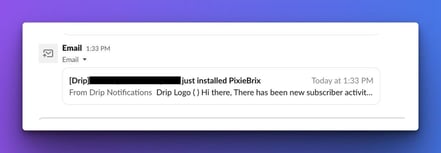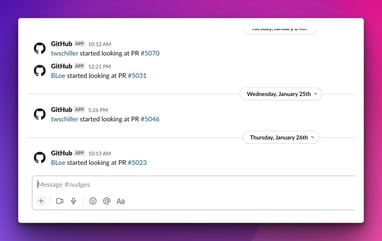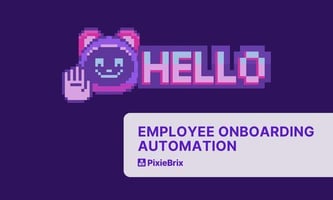This post discusses four ways that PixieBrix can multiply the ROI of your UiPath deployment.
3 Things We Don’t Automate as an Automation Startup
Automation can be a lifesaver. Whether you’re cutting out months of data entry, eliminating the need to jump between tools, or just brightening someone’s day, the right automation can completely change the game. But that doesn’t make it a one-size fits all solution. While it might be tempting to automate just about any process that requires manual work, some jobs really do need a human touch.
At PixieBrix, we’re huge on dogfooding our own tool, and that means we’ve automated a ton of our processes. But there are some things you just don’t automate, despite how easily you could.
But first…
Who are we?
At PixieBrix, our mission is to give everyone the superpower of customizing their user experience when working with browser-based applications and other websites. This superpower has been exclusive to developers and other roles with technical knowledge for years, but we’re building a low-code automation platform that makes it accessible to everyone.
We’re a small team from around the world that’s been working on this since 2021. We’re passionate about giving everyone the ability to create massive productivity gains and achieve a better quality of life with just a few lines of code.
What is PixieBrix?
It’s what we’ve been building! PixieBrix is a low-code platform anyone can use to build automations and enhancements in Chrome to streamline tasks and transform their workday. But it’s not just for builders! You can even streamline your process as a creator. With the wide range of premade mods on the PixieBrix marketplace, you can quickly deploy enhancements that make your workflows run smoother in minutes.
3 things we don’t automate as an automation startup
Despite being all about automation and helping people build their own, there are things we don’t automate. Not because we can’t, but because there’s inherent value in the human touch we can bring to these tasks. Here are three things we don’t automate at PixieBrix.
The personal operating manual

Every PixieBrix employee is encouraged to create a personal operating manual. It’s a guide to how they work and how their team can best collaborate with them. Above, you’ll see the one Brittany Joiner, our Head of Developer Relations and Community, created. It’d be easy to scrape some generic profile information from social media profiles and Slack, but we want everyone to take the time to create their operating manual. That helps us understand each other much more than just a list of interests and social bios.
Employees think through a series of questions, such as “How do you prefer receiving feedback?” and “What are things that people may misunderstand when working with you?” It takes time to fill out, but it really helps everyone get to know their teammates and learn about the folks on other teams. That way, their personality shines through, and everyone gets an in-depth guide to the best way to work together!
They take time to create — and read — but the end result is worth it. You feel like you’ve known your coworkers for a lifetime.
The every-other-day standup meeting
Daily standups can take a good chunk of time without discipline, which is why there are a ton of tools out there for running automated, asynchronous standup meetings. But as efficient as they might be, they undercut the whole purpose of the standup. When you’re working hard to build the next best thing, you don’t have a lot of time to get in touch with your colleagues outside of requesting help for specific tasks.
The daily — or thrice-weekly, as we do it — standup is the best chance to have ad-hoc conversations about what you’re working on, surface blockers, and unlock new opportunities for collaboration.
We wouldn’t dream of sacrificing that for a bit more productivity.
User feedback
As a young startup, we’re always moving fast and — rarely — breaking things. Working on a product that’s evolving so quickly means we need a lot of input to make sure we’re moving in the right direction. Whether that’s unlocking a use case we’d never considered, breaking ground on a new integration, or just implementing suggestions from our fantastic community, we rely heavily on user feedback.
Sure, we could easily build tools and forms that pull this information automatically, but we go out of our way to get as much face time with our users as possible. We talk to them, we watch how they use PixieBrix, and we listen closely to everything they have to say.
It’s the best way to make sure we keep building the right platform.
4 things we do automate
Because we’re trying to empower people to build the automations they need to make their lives easier, we do a lot of that with our own workflows. Here are just a few examples of the processes that we’ve automated at PixieBrix. These are processes that don’t need to be completely manual and, actually benefit from being completely automated.
Sending kudos to coworkers
We think that giving kudos to your coworkers should be as frictionless as possible. People should be recognized for their hard work, after all! That’s why we use this PixieBrix enhancement for Slack. That way, we can give kudos to our teammates from anywhere on the web — like, say, from a particularly difficult productboard issue.
New user notifications

We particularly love this automation that we added to our Slack workspace. Every time someone installs the PixieBrix extension, we get a Slack notification. It reminds us that users are the beating heart of PixieBrix, and it’s a nice motivational boost to the team when they’re working on something tricky.
Working with external contractors

Like many early-stage startups, we work with external contractors to fill out some of the gaps on our team. Whether that’s content marketers, developers, or specialized agencies, getting a little bit of help from external experts keeps us focused on what’s important: building the best Chrome extension out there! We use automations to sync whatever our contractors are working on from dedicated Trello boards to our own internal Trello boards. That way no one has to deal with a cluttered board full of cards that have nothing to do with their work.
GitHub nudges

Developers need a ton of focus time to get things done. Whether you’re deep in the code trying to squash a bug or figuring out how to make a new feature work, there’s nothing worse than a distracting Slack message from a well-meaning colleague. That’s why we used PixieBrix to create a button in GitHub that sends a quick message to Slack that let everyone else know what we’re working on. That way, we create more visibility and stay in sync without jumping back and forth between GitHub and Slack.
To automate or not to automate?
Because it’s so easy for us to roll out an automation for just about any process, we value our manual processes that much more. These are the processes that create tight-knit teams, give us a better sense of what our users want, and represent the kind of company we want to be. And because we’re such a tight-knit team, we’ll be building a much stronger platform that can handle any of the processes we’d rather automate.
Want to share the processes you’ve automated with us? Maybe you have your own thoughts on the workflows that benefit from a human touch? Join the PixieBrix Slack Community and tell us all about it. We can’t wait to meet you.

